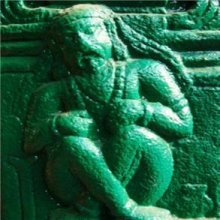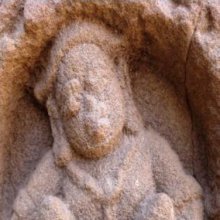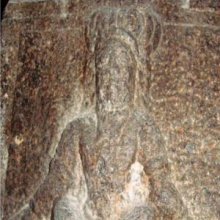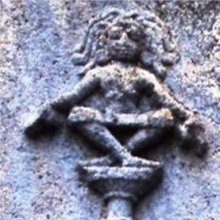Svastikasana, Svastika-asana, Svastikāsana: 11 definitions
Introduction:
Svastikasana means something in Hinduism, Sanskrit, Jainism, Prakrit. If you want to know the exact meaning, history, etymology or English translation of this term then check out the descriptions on this page. Add your comment or reference to a book if you want to contribute to this summary article.
Images (photo gallery)
In Hinduism
Yoga (school of philosophy)
Source: Wisdom Library: YogaSvastikāsana (स्वस्तिकासन) is one of the eighty-four āsanas (postures) taught by Śiva, according to the Haṭharatnāvalī 3.7-20. It is said that Ādinātha (Śiva) hand-picked 84 yoga postures from 84,00,000 living beings and taught them for the purpose of introducing physical health and well-being to the human body. The compound svastikāsana translates to svastika (lucky mark) and āsana (posture).
The 17th-century Haṭharatnāvalī is a Sanskrit reference book dealing with these āsanas (e.g., svastikāsana) which form a major constituent of the haṭhayoga practice. It was written by Śrīnivāsa.
Source: Google Books: The Hatha Yoga PradipikaSvastikāsana (स्वस्तिकासन) is the name of an āsana (posture), according to Haṭhayogapradīpikā I.21.—Accordingly, “Having kept both the hands under both the thighs, with the body straight, when one sits calmly in this posture, it is called svastikāsana”.
The 15th-century Haṭhayogapradīpikā by Svātmārāma is one of the oldest extant texts dealing with haṭhayoga: an ancient form of meditation founded by Matsyendranātha. The first chapter of this book describes various āsanas (e.g., svastika-āsana)
Source: archive.org: Yoga Tradition of the Mysore PalaceSvastikāsana (स्वस्तिकासन) is a type of posture (āsana), according to verse 59 of the Śrītattvanidhi.—Accordingly, “Place one foot on one thigh and sit on the other normally. This is svastikāsana, the auspicious”.
The 19th-century Śrītattvanidhi is a sanskrit treatise describing 80 primary āsanas, or ‘posture’ (e.g., dhenuka-āsana) and several additional ones.
These “meditation” āsanas are commonly referred to in most of the yoga texts with variations
Source: archive.org: Gheranda SamhitaSvastikāsana (स्वस्तिकासन) is one of the thirty-two āsanas (postures) taught in the second chapter of the Gheraṇḍasaṃhitā: “Placing the soles of the two feet between the knees and thighs, one should sit erect. This is called Svastikāsana”.
Svastikāsana is one of the selected 32 postures amongs 8,400,000 total mentioned by Śiva, according to Gheraṇḍasaṃhitā 2.1-2, “In all, there are as many Āsanas as species of animals. Eighty-four lacs of them are mentioned by Śiva. Out of them, 84 are regarded as important and among these 84, again 32 are good (enough) in this world of mortal beings”.
The 17th-century Gheraṇḍasaṃhitā (mentioning svastika-āsana) is one of the three classic texts of Haṭha-yoga: a major branch of Yoga, sharing similarities with the Yoga system taught by Patañjali, though claiming its own mythical founder known as Matsyendranātha. This gheraṇḍa-saṃhitā is an encyclopedic Sanskrit treatise describing thirty two such āsanas.

Yoga is originally considered a branch of Hindu philosophy (astika), but both ancient and modern Yoga combine the physical, mental and spiritual. Yoga teaches various physical techniques also known as āsanas (postures), used for various purposes (eg., meditation, contemplation, relaxation).
Shaktism (Shakta philosophy)
Source: Google Books: ManthanabhairavatantramSvastikāsana (स्वस्तिकासन) refers to the “posture of Svastika”, according to the Kularatnoddyota, one of the earliest Kubjikā Tantras.—Accordingly, “[...] (The gross form has) five faces, ten arms and, pure, it has a smiling face. [...] Her stomach is thin, navel, deep set and thighs large. (Her) hips and knees are very soft. She has beautiful thighs and red finger (nails) that are very beautiful. She (wears) beautiful cloths, a divine garland and an excellent shawl. (She wears) a necklace made of large gems, bangles on her limbs, anklets and a blazing diadem of rubies. O supreme mistress, adorned with divine rings (on her fingers), she sits on a svastika (as her) seat [i.e., svastikāsana-saṃsthitā]”.
Source: academia.edu: The Śāradātilakatantra on YogaSvastikāsana (स्वस्तिकासन) refers to one of the five āsanas (postures) explained by Lakṣmaṇadeśika in his 11th-century Śaradātilaka verse 25.12.—“Having placed the soles of both feet properly between both knees and thighs, the Yogin should sit with erect body; this they term the svastika [posture].”.

Shakta (शाक्त, śākta) or Shaktism (śāktism) represents a tradition of Hinduism where the Goddess (Devi) is revered and worshipped. Shakta literature includes a range of scriptures, including various Agamas and Tantras, although its roots may be traced back to the Vedas.
Shilpashastra (iconography)
Source: Shodhganga: The significance of the mūla-beras (śilpa)Svastikāsana (स्वस्तिकासन) refers to a type of Sthānāsana (poses dependent on the sthānaka), as defined according to texts dealing with śilpa (arts and crafs), known as śilpaśāstras.—One leg is held firmly supported on the ground, while the other is crossed over in front and rested on its toes. This posture is called svastikāsana. Svastikāsana is also called yogāsana in the seated posture. Whether the image is standing or seated with legs crossed, it is called svastikasana.
Svastikāsana is similar to the svastika-maṇḍala in Bharatanatyam.—The svastika-maṇḍala is the same in iconography also, but is labeled as svastikāsana. In iconography the legs are crossed in seated posture. The Yoga Narasimha in the Vaṭabhadra Śayana Temple in Sri Villiputtur is found in this svastikāsana posture. Kṛṣṇa is found in svastika-maṇḍala in the Sri Raṅganatha Temple in Sri Rangam as well as Venugopāla in the Rāmasvāmi Temple.

Shilpashastra (शिल्पशास्त्र, śilpaśāstra) represents the ancient Indian science (shastra) of creative arts (shilpa) such as sculpture, iconography and painting. Closely related to Vastushastra (architecture), they often share the same literature.
Pancaratra (worship of Nārāyaṇa)
Source: archive.org: Catalogue of Pancaratra Agama Texts1) Svastikāsana (स्वस्तिकासन) refers to one of the Mudrās mentioned in the eighteenth chapter of the Agastyasaṃhitā (agastya-suīkṣṇa-saṃvāda edition), an ancient Pāñcarātra Āgama text dealing with the worship of Rāma, Sītā, Lakṣmaṇa and Hanumān.—[Cf. the chapter pūjāsādhanalakṣaṇa].—[...] One should offer pūjā with devotion [bhakti] and orderliness [saṃkalpa]. [...] Postures [āsana] to be assumed during worship are then discussed—with descriptions of the following: [e.g., svastikāsana]. There are many others, the text adds, any one of which can be selected for the repetition of God’s names and for other pious activities [japādi].
2) Svastikāsana (स्वस्तिकासन) refers to one of the eight Āsanas (“yogic postures”) discussed in chapter 1 (Yogapāda) of the Padmasaṃhitā: the most widely followed of Saṃhitā covering the entire range of concerns of Pāñcarātra doctrine and practice (i.e., the four-fold formulation of subject matter—jñāna, yoga, kriyā and caryā) consisting of roughly 9000 verses.—Description of the chapter [āsanabheda-lakṣaṇa]:—Brahmā asks to know about Yogas. Bhagavān replies that there are two kinds of Yoga—karmayoga and jñānayoga. [...] A devotee may achieve liberation by either method [...] however, in the case of karmayoga it is to be noted that the eight steps are especially defined—Āsana, the third step, requires perfection of the eight positions [e.g., svastikāsana].

Pancaratra (पाञ्चरात्र, pāñcarātra) represents a tradition of Hinduism where Narayana is revered and worshipped. Closeley related to Vaishnavism, the Pancaratra literature includes various Agamas and tantras incorporating many Vaishnava philosophies.
In Jainism
General definition (in Jainism)
Source: archive.org: TrisastisalakapurusacaritraSvastikāsana (स्वस्तिकासन) or simply Svastika is the name of a posture (āsana), according to chapter 2.1 [ajitanātha-caritra] of Hemacandra’s 11th century Triṣaṣṭiśalākāpuruṣacaritra: an ancient Sanskrit epic poem narrating the history and legends of sixty-three illustrious persons in Jainism.
Accordingly, “the elephant of kings (i.e., Vimalavāhana) dismounted from the elephant’s shoulder and entered the garden, like a lion a mountain-cave. [...] He saw monks there, too, some in the [viz., svastikāsana-posture, ...] some engaged in kāyotsarga, and some in ukṣa-posture, indifferent to the body, who had carried out their vows in the midst of numerous attacks, like soldiers in battles, victorious over internal enemies, enduring trials, powerful from penance and meditation [...] The King, with devotion sprouted in the guise of horripilation, as it were, approached Ācārya Arindama and paid homage to him”.

Jainism is an Indian religion of Dharma whose doctrine revolves around harmlessness (ahimsa) towards every living being. The two major branches (Digambara and Svetambara) of Jainism stimulate self-control (or, shramana, ‘self-reliance’) and spiritual development through a path of peace for the soul to progess to the ultimate goal.
Languages of India and abroad
Sanskrit dictionary
Source: Cologne Digital Sanskrit Dictionaries: Monier-Williams Sanskrit-English DictionarySvastikāsana (स्वस्तिकासन):—[from svastika > sv-asti] n. a mode of sitting (See above), [Sarvadarśana-saṃgraha]
Sanskrit, also spelled संस्कृतम् (saṃskṛtam), is an ancient language of India commonly seen as the grandmother of the Indo-European language family (even English!). Closely allied with Prakrit and Pali, Sanskrit is more exhaustive in both grammar and terms and has the most extensive collection of literature in the world, greatly surpassing its sister-languages Greek and Latin.
Kannada-English dictionary
Source: Alar: Kannada-English corpusSvastikāsana (ಸ್ವಸ್ತಿಕಾಸನ):—[noun] a particular yogic posture.
Kannada is a Dravidian language (as opposed to the Indo-European language family) mainly spoken in the southwestern region of India.
See also (Relevant definitions)
Partial matches: Svastika, Asana.
Query error!
Full-text: Asana, Svastika, Cuttikatanam, Jangha, Angushtha, Tiryaga, Anguli, Uttana, Maudgalya, Akuncita, Kincit, Kincidakuncita, Akshasutraka.
Relevant text
Search found 19 books and stories containing Svastikasana, Svastika-asana, Svastika-āsana, Svastikāsana; (plurals include: Svastikasanas, asanas, āsanas, Svastikāsanas). You can also click to the full overview containing English textual excerpts. Below are direct links for the most relevant articles:
Garga Samhita (English) (by Danavir Goswami)
Verse 4.16.4 < [Chapter 16 - The Srī Yamunā Armor]
The concept of Yoga in Yoga Upanishads (by Philomina T.L)
2.3. Āsana (according to the Major Upaniṣads) < [Chapter 3 - The Reflections on Yoga in the Major Upaniṣads]
6.3. The concept of Āsana (physical posture) < [Chapter 2 - Principal Tenets of Yoga]
3. The Classifications of Yoga < [Chapter 4 - The contents of the Yogopaniṣads]
Puranic encyclopaedia (by Vettam Mani)
Samkhya thoughts in the Mahabharata (by Shini M.V.)
Yoga Philosophy in Śānti-parva < [Chapter 3 - The Philosophical Tenets in the Śānti-parva]
Yoga-sutras (with Bhoja’s Rajamartanda) (by Rajendralala Mitra)
Sūtra 2.46 < [Second Chapter (Sadhana Pada)]
Yoga-sutras (Ancient and Modern Interpretations) (by Makarand Gopal Newalkar)
Sūtra 2.46 [Āsana—posture] < [Book II - Sādhana-pāda]



